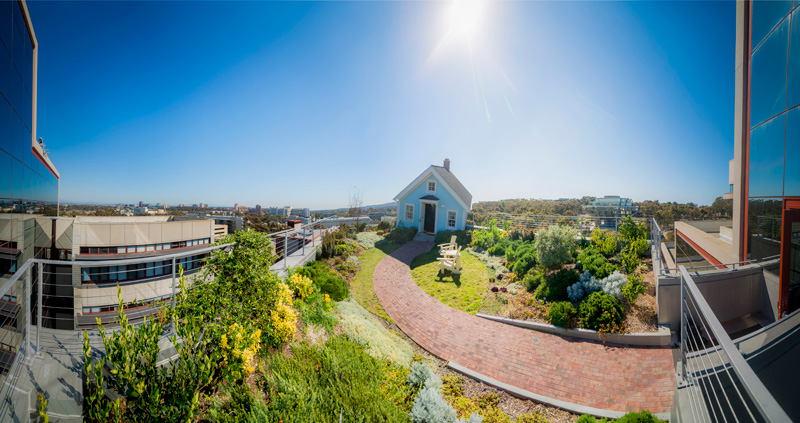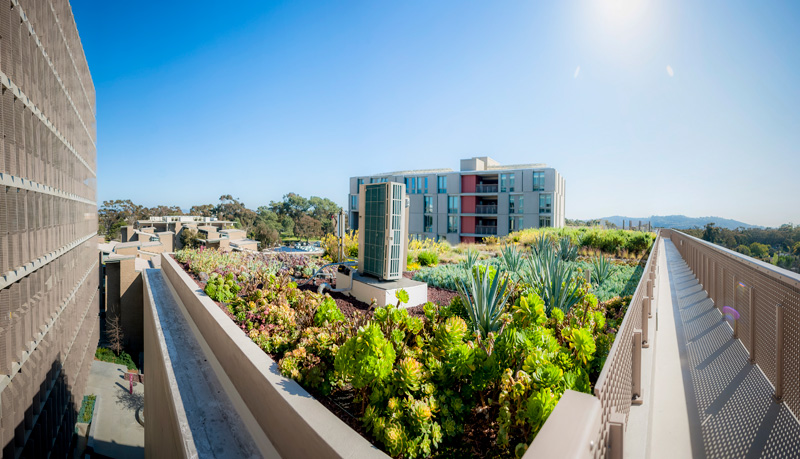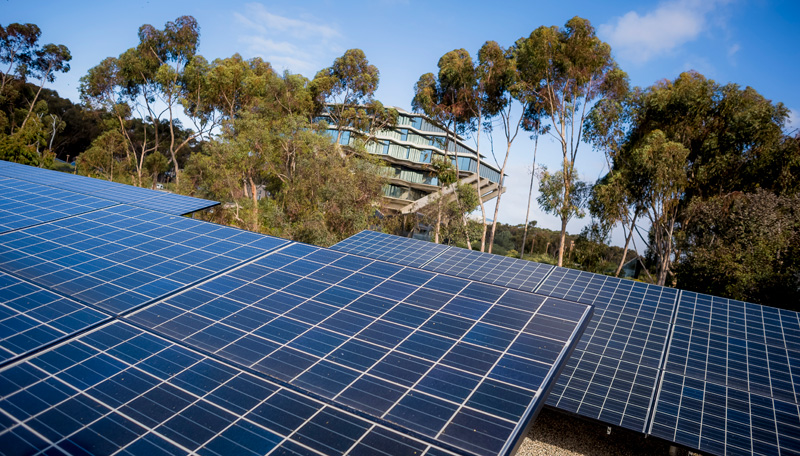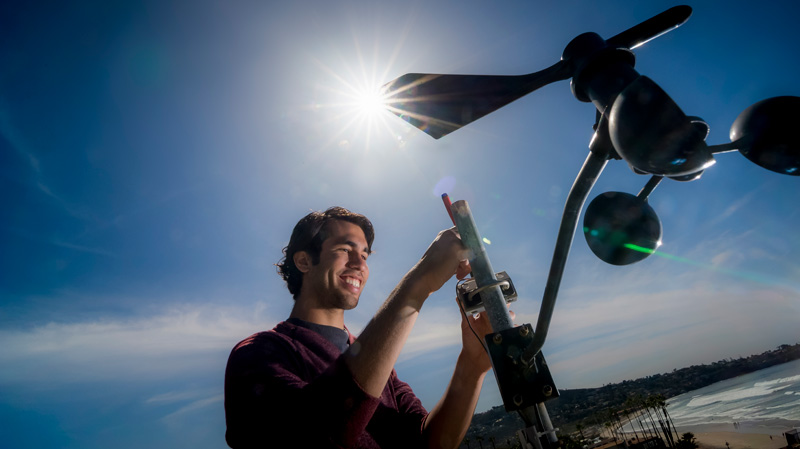UC San Diego Among Multidisciplinary Awards Providing $221M Nationally for Cutting-Edge Projects
Technology & Engineering
By:
Published Date
By:
Share This:

Photos by Erik Jepsen/UC San Diego Publications
UC San Diego’s commitment to sustainability can be found in its teachings, research, operations—even on the university’s rooftops. The campus is increasingly using the space atop its structures to innovatively reduce its environmental footprint.
The garden roof atop Revelle College’s Charles David Keeling apartments is open to the public. You can either take the elevator to the sixth floor or the stairs located at the North and South towers.
Guided tours of the Stuart Collection’s “Fallen Star” are available Tuesdays and Thursdays from 11 a.m. to 2 p.m.
By the end of 2013, 34 structures on UC San Diego’s campus and its affiliated sites will be equipped with solar photovoltaic panels. Recently, the university also unveiled a vegetative roof, atop Revelle College’s LEED Platinum-certified Charles David Keeling apartments. In addition, more than a dozen wireless sensors that determine the optimal times to gain and expend energy are now poised on UC San Diego rooftops. And solar hot water heating and water collection systems are located above some of the very buildings where UC San Diego students live and learn about climate change and ways to conserve, reuse and recycle.
“Sustainability is part of UC San Diego’s institutional DNA, inherited from our founders and early scientists at Scripps Institution of Oceanography,” said UC San Diego Chancellor Pradeep K. Khosla. “UC San Diego has transformed into a living laboratory for innovation. Even our rooftops are a testament to our commitment to use all of the space on campus to promote research and identify sustainable solutions.”
With roughly 11 million square feet of space and more than 700 buildings at UC San Diego, reducing energy consumption used to heat and cool buildings by even a small percentage ensures significant long-term savings.

More than 4,000 plants can be found on the rooftop garden of LEED Platinum-certified Keeling apartments at Revelle College. The garden is designed to create energy savings as well as provide more study and relaxation space for students. According to Revelle College junior Ari Ananda, the rooftop is most popular at sunset. “It’s a wonderful place for students to reflect and watch the sun set over the ocean,” Ananda said. “I think it makes residents more aware of the natural beauty all around our campus.”
Richard Thomas, also a junior at Revelle College, added, “One of my favorite activities to do is bring my guitar up there or read.”
The “green roof” has vegetation that’s planted over a waterproof casing. It helps absorb rainwater, provide insulation to reduce heating and cooling costs and creates new wildlife habitats.
The garden, shrouded with plants, includes drought-tolerant succulents, flowering plants and low-spread shrubs such as English stonecrop and reflexed stonecrop. Snow-in-summer was planted on the surface of the barrier in a special soil mix of aged compost, lava rock and coarse sand.
“I think when students learn about the sustainable features of the Keeling apartments and rooftop garden with desert succulents and recycled water, it makes them more environmentally conscious,” Ananda said.
Revelle College was not the first to don a rooftop garden. Jacobs Hall also features a garden that accompanies “Fallen Star,” the 18th addition to the Stuart College, a renowned series of site-specific sculptures at UC San Diego. The garden, which features a plum tree, a wisteria vine, tomatoes, also helps insulate the building.

From the Hopkins Parking Structure to the Birch Aquarium and the Mandell Weiss La Jolla Playhouse––solar photovoltaic panels can be found on UC San Diego’s buildings across the campus.
UC San Diego currently has 2.3 megawatts of solar photovoltaic capacity installed on its rooftops and parking garages. The campus recently reached an agreement with a local solar company to install an additional 863 kilowatts of solar power at UC San Diego. The project will bump UC San Diego’s rooftop solar installations from 26 to 34. In addition, the campus has three ground mounted solar systems.
Not only will the new solar power project save the university about $2 million over 20 years, but it also will be showcasing UC San Diego as a leader in sustainability while supporting the local and national economies, according to Dave Weil, UC San Diego director of building commissioning and sustainability.
“Being an academic institution, we know that these projects serve as an example for the future leaders and great minds of this region,” Weil said.
UC San Diego has become a state leader in the deployment of solar power, now having more solar deployed than any other university in San Diego. All tolled, with the new solar project, UC San Diego will have about 3 megawatts of solar on its facilities—the equivalent of the amount of energy needed to power about 1,000 homes. The solar power will contribute to the campus’s renewable-energy generating capacity; it is estimated that all these systems combined will reduce CO2 emissions by about 3,056,000 pounds per year.
In addition to contributing to UC San Diego’s renewable energy, solar panels also help insulate the buildings that house them because of their reflective properties.
Some structures cannot support the installation of solar panels and in many of these cases, UC San Diego’s roofs are “cooled” with a white surface or have a reflective membrane to help keep energy costs down during summer months, especially when compared to rooftops that are darker and absorb enormous amounts of heat.
According to engineering professor Jan Kleissl, these roofs can get up to 140 degrees Fahrenheit. “The surface can get so hot, you can literally burn you hand on it,” Kleissl said.
A reflective or “cool” roof has the ability to reflect the visible, infrared and ultraviolet wavelengths of the sun, reducing heat transfer to the surface. Such roofs can be found on top of the Price Center, Atkinson Hall, the Telemedicine Learning Center, the Housing, Dining and Hospitality administration building and other structures on campus.
Kleissl encourages all homeowners in hot climates to explore the option of installing a reflective or “cool” roof on their home as they offer local and global benefits, including the ability to save 15 percent of the annual air-conditioning energy use in a single-story building.

San Diego is known for its sunny skies and temperate climate, but rain or shine, UC San Diego students and faculty have found both cloudy skies and warm summer days to be equally useful in gaining information that can be used to enhance energy conservation and production on campus.
The campus is home to more than 13 wireless weather-monitoring sensors called Decision Making using Real-time Observations for Environmental Sustainability (DEMROES), which collect and archive weather condition data around the clock. These solar-powered sensors provide a more accurate, customized and real-time look at weather conditions, allowing them to track the optimal time to use ocean breezes to cool buildings and identify the sunniest rooftops to expand solar energy projects.
Designed in 2008 by Kleissl and his students, the network is unprecedented in the United States for the density of weather data that it collects.
DEMROES reveal the temperature variations that occur across campus, from the cooler coast near Scripps Institution of Oceanography to the warmer east side of campus near Moore’s Cancer Center. The data the system collects on temperature, humidity, rainfall, wind speed and solar radiation allows researchers to predict microclimate impacts on building energy performance, such as natural ventilations to cool buildings and bright sunlight to heat structures.
Kleissl also is using the project to teach students and inspire them to seek careers in which they can help reduce energy use.
Both graduate students and undergraduates have been involved in designing, installing and upkeeping the DEMROES network at UC San Diego.
“From constructing the stations, to programing the sensors, there is a lot of opportunity for students at any skill level to participate in the project,” said Kleissl. “We hopefully can direct these students and open their eyes to opportunities and how to practically apply their research to projects with a positive impact.”
Felipe Mejia, a first-year doctoal student in engineering now heads up the project. “I first got involved because I really like hands-on projects and working in the field,” Mejia said. “The DEMROES system provides a large amount of data that is used to both validate our solar forecasting studies and provide input to building management systems across the campus.”
Scripps Institution of Oceanography is home to one roof barrel that collects water that is reused for various purposes. Rain barrels help reduce the flow of storm water by capturing and storing roof runoff. The barrel at SIO prevents storm water from flowing across a paved surface or landscaped areas that pick up pollutants on the ground such as oil, sediment, and pesticides, preventing them from going into a storm drain that flows to the ocean. “Rain barrels also help conserve water when used to water plants, lawns and gardens,” said Kristin Kielich, sustainability manager at UC San Diego.
Kielich added that although much can still be done, UC San Diego has already met and/or exceeded its water conservation goals outlined in the UC San Diego’s Climate Action Plan since 2008.
UC San Diego’s initiatives to conserve water include the usage of native plants and/or succulents and 75 percent of water in the campus’s landscape irrigation system is recycled. In addition, the campus utilizes sprinklers that only water landscape and UC San Diego’s older buildings are in the process of being retrofitted to include water efficient valves in all sinks.
“The commitment from UC San Diego’s students, staff and faculty to sustainability is unwavering,” Kielich said. “From water conservation to renewable energy and recycling—UC San Diego’s comprehensive sustainability initiatives transform current research into new innovations that help ensure a healthier planet in the future.”
Share This:
Keep up with all the latest from UC San Diego. Subscribe to the newsletter today.